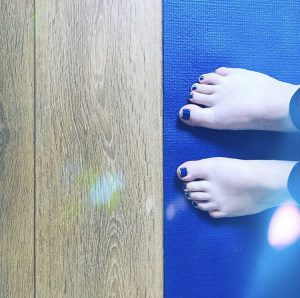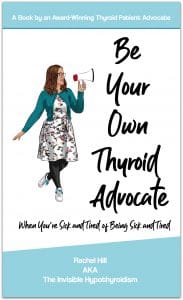Originally published on 31st May 2022 Last updated on 15th July 2024
Exercise is an important part of a healthy lifestyle and can help us to feel better and manage symptoms with a thyroid condition, but it’s important to get the balance right.
So how do you find what is actually going to improve your health instead of causing more fatigue and flare ups?
5 Do’s and Dont’s for Exercising With Hypothyroidism and Hashimoto’s
1. Knowing Limits
Don’t: Push Yourself Too Far
Do: Listen To Your Body
Exercising with thyroid disease can prove difficult and if you used to be a very active person before the onset of your thyroid condition, it can be hard to accept that your exercise regimen may need to change so as not to make yourself more unwell.
After all, repeatedly over exercising can lead to thyroid flares and setbacks in your health. Learning to get the balance right and relearning what your body is comfortable doing is crucial in living a life with your thyroid condition well-managed.
Over exercising isn’t good for anyone, and neither is doing the wrong type of exercise for your body.
Repeatedly engaging in overly demanding exercise can cause a surge of biochemical imbalances to occur within the body, including the disruption of the hypothalamus-pituitary axis, which can affect thyroid function and adrenal health.
Intense cardio, marathon training, weight lifting etc. with little to no recovery time can all cause extreme stress to the body, particularly thyroid function. However, we are all different and some thyroid patients can maintain these forms of exercise.
When too much cortisol is produced, as can happen when we overexert ourselves, it can inhibit thyroid function and cause adrenal dysfunction, where, even if our thyroid test results look OK, we may still feel unwell.
Stop comparing yourself to other people and other thyroid patients. We have to rediscover our personal new happy place within exercise and movement. Starting from scratch may be necessary and ditching any preconceptions of what your exercise ‘should’ look like is helpful. Let your body tell you.

Rachel cycling in Bruges
2. Be Experimental
Don’t: Force Types of Exercise You Think You ‘Should’ Be Doing
Do: Try New Things
Pay attention to how different types of exercise make you feel.
Signs that you may need to reevaluate your exercise regimen include:
- Mood swings
- Fatigue that is long-lasting
- Thyroid flare ups following exercise
- Blood sugar dips after working out
- Feeling muscle weakness and shakiness after working out
- Disrupted sleep
- Mental health conditions such as anxiety and depression
- Brain fog or cognitive issues
- Feeling worse after working out instead of more energised
Exercise options that tend to be popular among thyroid patients include: yoga, pilates, swimming, walking, cycling and even dancing.
Avoid for now any exercise that is clearly hindering you, worsening your health, makes any of your thyroid symptoms worse, or is too intensive or high-impact.
As well as the type of exercise, consider how often your body is happy to do it, too. It may not benefit from a 5k run everyday, but a 45-minute walk every couple of days can work really well instead.
Some days you may feel up to walking and on less-energetic days some yoga stretches can help your body more.
You may need to apply some trial and error as you give a few different types of exercise a go and see how your body reacts. You want to be promoting more energy instead of only draining yourself further. You should feel energised and happy after exercise, not worse off.
Always increase intensity and frequency slowly and if your body struggles, please do listen to it.
It is obviously crucial to mention here that every person (and every thyroid patient) will be different. We will all have different needs when it comes to exercise, from type of exercise to frequency and intensity. You may well need to experiment with different types and frequencies to see what does and does not work for your body.
The time of day can also impact when you exercise. If you find that your blood sugar levels are affected or you have cortisol issues (many of us feel at our worst in the morning), you may find it better to exercise later on in the day, such as at lunchtime or in the afternoon.

Yoga can be really useful
3. Move With Your Thyroid Health
Don’t: Be Rigid in Your Routine
Do: Keep Reassessing
If:
- Your thyroid levels change
- You experience a flare
- Life gets more busy and stressful
- Thyroid symptoms are coming back
reassess your routine.
Do you need to do something less intense until your symptoms come more under control, you have more time to exercise or your body tells you it can handle more?
Often, more restorative exercise such as yoga can be useful during these times.
4. Adrenal Health
Don’t: Focus Entirely On Your Thyroid Health
Do: Look at Adrenal Dysfunction Symptoms and Consider Testing if They Apply
A sign of adrenal issues can include trying to exercise, only to find that you crash, feeling light-headed and faint. Read more about this here.
You may order or ask for a 24 hour saliva test, testing your cortisol levels at four key points of the day, to find out if you have adrenal / cortisol issues. If your doctor agree to do this, you can very simply order it yourself and complete it at home. You can find testing options here and here.
Of course, any of the above symptoms need reporting to your doctor as soon as possible, too. Especially heart palpitations, dizziness and back pain. Don’t force exercise when you’re experiencing anything like this.
5. Be Kind to yourself
Don’t: Feel Guilt or Shame for Exercising Less Than You’d Like To
Do: Focus On What Your Body Needs From You Right Now
I still sometimes find myself beating myself up for not doing as much of a workout or not exercising as much as I had wanted to, that day.
However, the thing is:
your body won’t always be able to do exactly the same thing every single day. There are so many factors that can change day to day.
I know that for me, how much sleep I got the night before, how well nutritiously I have eaten that day, how mentally drained I feel, what other to-do’s I have to get done and basically just what my thyroid condition is like that day all play a part.
There are so many factors that affect whether I can exercise as much as I’d like to. Some weeks I do more and some weeks I do less, because I listen to my body and do what it will safely be able to do.
Give yourself some flexibility and respect your body enough to know when to listen to it and follow its lead. The other night for example, I just didn’t feel up to yoga at all but as I hadn’t done it in a week I still got on the yoga mat but chose to do a gentler session compared to the week before.
I do my best to fit exercise into my every day in a realistic way. And most importantly, in a way that does not make my health condition worse.
Sometimes it is just rest and restorative exercise. Sometimes I can’t exercise at all until my thyroid condition is back under control. Guilt and shame do not help with recovery.
The same can also be said for focusing on exercise as a means to ‘change your body’ and ‘burn calories’ over anything else.
You can read more about why I don’t focus on weight loss as a thyroid health advocate in my longer article here, but in short:
Doing so often makes your physical health worse, promoting endocrine issues such as thyroid and adrenal conditions.
Limiting calories can reduce Free T3 levels (the active thyroid hormone), and focusing only on ‘calories in VS calories out’ may lead to adrenal dysfunction and poor gut health since it’s not focusing on nourishing your body with lots of nutrient dense foods, healthy exercise and plenty of recuperation.
What exercise works for you as a thyroid patient? Feel free to share in the comments.
See also:








